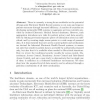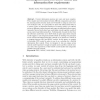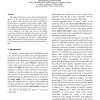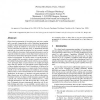CCS
2007
ACM
14 years 2 months ago
2007
ACM
The problem of key management for access control systems has been well-studied, and the literature contains several schemes for hierarchy-based and temporal-based access control. ...
BPM
2007
Springer
14 years 2 months ago
2007
Springer
There is currently a strong focus worldwide on the potential of large-scale Electronic Health Record systems to cut costs and improve patient outcomes through increased efficiency....
ASIAN
2007
Springer
14 years 2 months ago
2007
Springer
Current information systems are more and more complex. They require more interactions between different components and users. So, ensuring system security must not be limited to us...
ACSAC
2009
IEEE
14 years 2 months ago
2009
IEEE
Abstract--Current Network Access Control (NAC) technologies manage the access of new devices into a network to prevent rogue devices from attacking network hosts or services. Typic...
ECOOPW
1998
Springer
14 years 2 months ago
1998
Springer
PrincipalDomain is an administrative scoping construct for establishing security policies based on the principals invoking object services that may entail objects moving around a ...
CCS
1994
ACM
14 years 3 months ago
1994
ACM
This paper describes an access control mechanism that enforces at the network level an access control decision that is taken at the application level. The mechanism is based on th...
WETICE
1996
IEEE
14 years 3 months ago
1996
IEEE
This paper describes a security architecture designed to support role-based access control for distributed object systems in a large-scale, multi-organisational enterprise in whic...
SP
1997
IEEE
14 years 3 months ago
1997
IEEE
A major drawback of existing access control systems is that they have all been developed with a specific access control policy in mind. This means that all protection requirement...
HOTOS
1997
IEEE
14 years 3 months ago
1997
IEEE
The recent trend towards dynamically extensible systems, such as Java, SPIN or VINO, promises more powerful and flexible systems. At the same time, the impact of extensibility on...
NSPW
1998
ACM
14 years 3 months ago
1998
ACM
Object-based programming is becoming more and more popular and is currently conquering the world of distributed programming models. In object-based systems access control is often...





